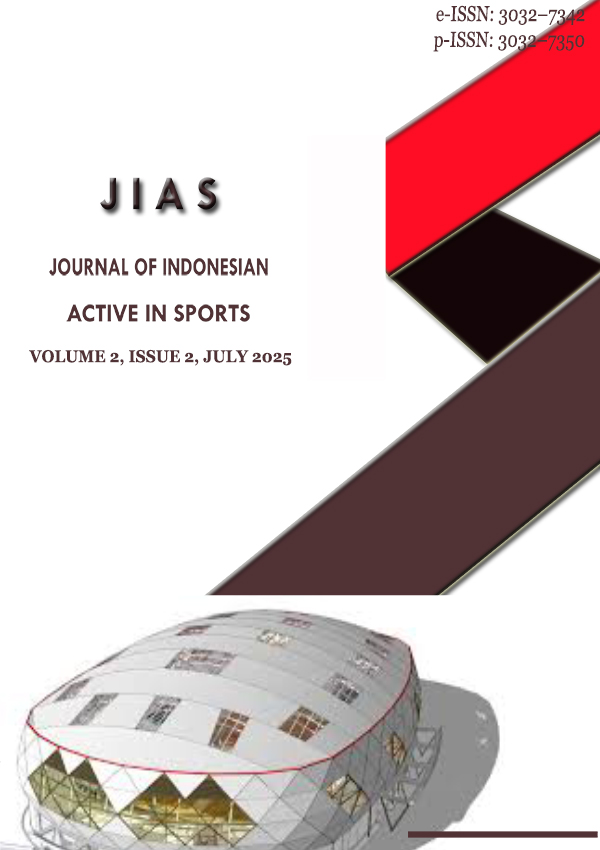Evaluating Plyometric Circuit Training for Enhancing Explosive Power and Sprint Times
DOI:
https://doi.org/10.24114/jias.v2i2.64528Abstract
This study investigates the impact of circuit training on enhancing leg muscle power and 200-meter sprinting speed among athletes of PASI Mandailing Natal, addressing prevalent deficiencies in these performance metrics. Employing a one-group pretest-posttest experimental design, six male athletes were subjected to a six-week training program, conducted three times weekly. The intervention comprised eight structured stations targeting strength, power, and speed through exercises such as squat jumps and box jumps, progressively increasing in intensity. Performance was assessed using standing broad jump tests for leg muscle power and stopwatch measurements for 200-meter sprint times. Statistical analyses, including paired t-tests and ANOVA, revealed significant improvements: mean leg muscle power increased by 32.83 cm, while sprinting times decreased by 2.98 seconds. These findings underscore the efficacy of circuit training in stimulating neuromuscular coordination and anaerobic adaptations, crucial for sprint performance. The reduction in performance variability further highlights the program's adaptability to diverse fitness levels. This study provides evidence-based validation of circuit training as a practical and efficient approach for athletic development, with implications for optimizing competitive readiness. Future research should explore individual exercise contributions within the protocol to refine training strategies. The results contribute to sports science literature, offering actionable insights for coaches seeking targeted interventions to enhance sprint performance.References
Ali, M. M., Hussain, A. A., & Jasim, M. M. (2022). The effect of Tabata exercises on muscle power and running speed in under-20 200 metres runners. SPORT TK-Revista EuroAmericana de Ciencias del Deporte, 11(Supplement 1), 7. doi:https://doi.org/10.6018/sportk.509391
Ando, R., Kojima, C., Okamoto, S., Kasai, N., Sumi, D., Takao, K., . . . Suzuki, Y. (2024). Effect of 6-Week Sprint Training on Long-Distance Running Performance in Highly Trained Runners. International Journal of Sports Physiology and Performance, 19(7), 645-650. doi:https://doi.org/10.1123/ijspp.2023-0342
Annasai, F., Sumaryanti, Nugroho, S., Hartanto, A., & Arianto, A. C. (2023). Circuit training based physical condition training model to increase speed, agility, arm power, and limb muscle power of basketball athletes. Pedagogy of Physical Culture and Sports, 27(4), 282-288. doi:https://doi.org/10.15561/26649837.2023.0403
Babu, M. S., & Kumar, P. P. S. P. (2013). The effect of selected circuit training exercises on sprinters of high school girls. International Journal of Science and Research (IJSR), 2(11), 401-407.
Bastholm, M., & Olsen, G. (2024). The Role of Plyometric Training in Improving Explosive Power in Sprinters: A Qualitative Analysis. International Journal of Sport Studies for Health, 7(3), 71-79. doi:https://doi.org/10.61838/kman.intjssh.7.3.10
Bijarga, P. B. (2023). The Effect Of 6 Weeks Of Physical Fitness Training On Body Composition, Endurance, And Specific Performance Of 14-17 Years Old Taekwondo Athletes. Malaysian Sports Journal (MSJ), 4(2), 26-30. doi:http://doi.org/10.26480/msj.02.2023.26.30
Creswell, J. W., & Creswell, J. D. (2017). Research Design: Qualitative, Quantitative, and Mixed Methods Approaches (5 ed.). Thousand Oaks: Sage.
Deshmukh, Y., & Dhokrat, G. (2025). Effect of Circuit Training for the Promotion of Speed, Strength and Performance in Selected Track and Field Events. Amitesh Publication & Company, 13(72), 31-35.
Field, A. (2013). Discovering Statistics Using IBM SPSS Statistics (4 ed.). Thousand Oaks: Sage.
Ghasemi, A., & Zahediasl, S. (2012). Normality Tests for Statistical Analysis: A Guide for Non-Statisticians. Int J Endocrinol Metab, 10(2), 486-489. doi:https://doi.org/10.5812/ijem.3505
Haff, G. G., & Triplett, N. T. (2015). Essentials of strength training and conditioning 4th edition (4 ed.). Champaign: Human Kinetics.
Kahraman, Y., & Hocalar, A. (2024). Circuit resistance training strategy on maximal strength, rate of force development and power: A random model meta-analysis. Journal Sport Area, 9(2), 246-254. doi:https://doi.org/10.25299/sportarea.2024.vol9(2).15885
Kasper, K. (2019). Sports Training Principles. Current Sports Medicine Reports, 18(4), 95-96. doi:https://doi.org/10.1249/JSR.0000000000000576
Lockie, R. G., Jalilvand, F., Callaghan, S. J., Jeffriess, M. D., & Murphy, A. J. (2015). Interaction Between Leg Muscle Performance and Sprint Acceleration Kinematics. J Hum Kinet, 49, 65-74. doi:https://doi.org/10.1515/hukin-2015-0109
Mackala, K., & Fostiak, M. (2015). Acute Effects of Plyometric Intervention—Performance Improvement and Related Changes in Sprinting Gait Variability. The Journal of Strength & Conditioning Research, 29(7), 1956-1965. doi:http://doi.org/10.1519/JSC.0000000000000853
Maćkała, K., Michalski, R., & Ćoh, M. (2010). Asymmetry of step length in relationship to leg strength in 200 meters sprint of different performance levels. Journal of Human Kinetics, 25(1), 101-108. doi:10.2478/v10078-010-0037-y
Mahalingam, M., Saibya, S., Pandey, G., Karmakar, D., Rajpoot, Y. S., Elayaraja, M., . . . Gogoi, H. (2024). Effectiveness of High-Intensity Circuit Training on Physical Fitness Among Athletes: A Systematic Review of Randomized-Controlled and Non-Controlled Trials. Fizjoterapia Polska, 24(3), 145-157. doi:http://doi.org/10.56984/8ZG020AWUR
Mola, D. W., & Bayısa, G. T. (2020). Effect of circuit training on selected health-related physical fitness components: the case of sport science students. Turkish Journal of Kinesiology, 6(4), 142-148. doi:https://doi.org/10.31459/turkjkin.812512
Pallant, J. (2020). SPSS survival manual: A step by step guide to data analysis using IBM SPSS (7 ed.). London: Routledge.
Pandy, M. G., Lai, A. K. M., Schache, A. G., & Lin, Y.-C. (2021). How muscles maximize performance in accelerated sprinting. Scandinavian journal of medicine & science in sports, 31(10), 1882-1896. doi:https://doi.org/10.1111/sms.14021
Ramos-Campo, D. J., Andreu Caravaca, L., Martínez-Rodríguez, A., & Rubio-Arias, J. Á. (2021). Effects of Resistance Circuit-Based Training on Body Composition, Strength and Cardiorespiratory Fitness: A Systematic Review and Meta-Analysis. Biology, 10(5), 377. doi:https://doi.org/10.3390/biology10050377
Ravi, P., & Kalimuthu, D. (2023). Potential Role of Circuit Training and Ladder Training in the Development of Anaerobic Power and Explosive Performance of School Students. Journal of Pharmaceutical Negative Results, 14(2).
Sáez de Villarreal, E., Requena, B., Izquierdo, M., & Gonzalez-Badillo, J. J. (2013). Enhancing sprint and strength performance: Combined versus maximal power, traditional heavy-resistance and plyometric training. Journal of Science and Medicine in Sport, 16(2), 146-150. doi:https://doi.org/10.1016/j.jsams.2012.05.007
Sonchan, W., Moungmee, P., & Sootmongkol, A. (2017). The effects of a circuit training program on muscle strength, agility, anaerobic performance and cardiovascular endurance. International Journal of Medical, Health, Biomedical, Bioengineering and Pharmaceutical Engineering, 11(4), 170-173.
Voisin, S., Jacques, M., Lucia, A., Bishop, D. J., & Eynon, N. (2019). Statistical Considerations for Exercise Protocols Aimed at Measuring Trainability. Exercise and Sport Sciences Reviews, 47(1), 37-45. doi:https://doi.org/10.1249/JES.0000000000000176
Downloads
Published
How to Cite
Issue
Section
License
Copyright (c) 2025 Muhammad Ardiansyah, Irwansyah Siregar, & Rafika Ardilla

This work is licensed under a Creative Commons Attribution-ShareAlike 4.0 International License.












